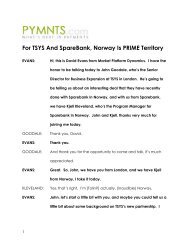Two-Sided Market - PYMNTS.com
Two-Sided Market - PYMNTS.com
Two-Sided Market - PYMNTS.com
Create successful ePaper yourself
Turn your PDF publications into a flip-book with our unique Google optimized e-Paper software.
CHAPTER ONE<br />
Industrial organization of <strong>Two</strong>-<strong>Sided</strong> Platforms<br />
CHAPTER TWO<br />
Some Empirical Aspects of Multi-<strong>Sided</strong> Platform Industries<br />
CHAPTER THREE<br />
How Catalysts Ignite:<br />
The Economics of Platform-Based Startups<br />
7 TABLE OF CONTENTS<br />
Part One<br />
Abstract:<br />
Many diverse industries are populated by businesses that operate two-sided platforms. These<br />
businesses serve distinct groups of customers who need each other in some way, and the core<br />
business of the two-sided platform is to provide a <strong>com</strong>mon (real or virtual) meeting place and to<br />
facilitate interactions between members of the two distinct customer groups. Platforms play an<br />
important role throughout the economy by minimizing transactions costs between entities that can<br />
benefit from getting together. In these businesses, pricing and other strategies are strongly affected<br />
by the indirect network effects between the two sides of the platform. As a matter of theory, for<br />
example, profit-maximizing prices may entail below-cost pricing to one set of customers over the<br />
long run and, as a matter of fact, many two-sided platforms charge one side prices that are below<br />
marginal cost and are in some cases negative. These and other aspects of two-sided platforms<br />
affect almost all aspects of antitrust analysis - from market definition, to the analysis of cartels,<br />
single-firm conduct, and efficiencies. This paper provides a brief introduction to the economics of<br />
two-sided platforms and the implications for antitrust analysis.<br />
Abstract:<br />
Multi-sided platform markets have two or more different groups of customers that businesses<br />
have to get and keep on board to succeed. These industries range from dating clubs (men and<br />
women), to video game consoles (game developers and users), to payment cards (cardholders and<br />
merchants), to operating system software (application developers and users). They include some of<br />
the most important industries in the economy. A survey of businesses in these industries shows that<br />
multi-sided platform businesses devise entry strategies to get multiple sides of the market on board<br />
and devise pricing, product, and other <strong>com</strong>petitive strategies to keep multiple customer groups on a<br />
<strong>com</strong>mon platform that internalizes externalities across members of these groups.<br />
Abstract:<br />
Entrepreneurs who start multi-sided platforms must secure enough customers on both sides,<br />
and in the right proportions, to provide enough value to either group of customers and to achieve<br />
sustainable growth. In particular, these entrepreneurs must secure “critical mass” to ignite the<br />
growth of their platforms; the failure to achieve “critical mass” quickly results in the implosion of<br />
the platform. There are a number of strategies available to entrepreneurs to reach critical mass.<br />
For example, the “zig-zag” strategy involves successive accretions of customers on both sides to<br />
build up the value to both. The relevant strategies depend in large part on whether the nature of<br />
the platform requires securing participation by both platform sides at launch (e.g. dating venues),<br />
whether it is possible to acquire one side before approaching the other side (e.g. search engines),<br />
and whether it is necessary to make pre-<strong>com</strong>mitments to one side to induce them to make<br />
investments (e.g. video games).<br />
EConoMICS of MulTI-SIdEd<br />
PlATforM BuSInESSES








